As most readers will know, Schweinfurt was the center of ball bearing manufacturing in Germany and was, therefore, a strategic target. The 8th Air Force had last bombed this target in October of 1943, suffering extremely high losses.
On the morning of the 24th, Art, along with the rest of the crew, was rousted at 0400 to attend the briefing for the day. When Schweinfurt was announced as the primary target, the entire group groaned.
All crews were ordered to fly. All aircraft that were airworthy would fly. After twenty three missions, the "No Balls" (B-17F-25-DL, serial number 42-3136, code DS-P) had seen better days. Art's single 50 caliber machine gun, spring mounted in a hole in the Plexiglas nose, would also become a problem later on in the mission.
Takeoff was at 0600, and it would be in foggy weather. Art was loading one of the 50 caliber cheek guns as the "No Balls" was taking off. For some reason, it started firing. The gun was aimed at the hangars, and had to be stopped quickly. Art threw the ammo belt over the gun to jam it. It stopped firing, but the gun would be useless the rest of the day. Art always wondered what would have happened if they had returned from the mission that day. He never knew if anyone along the flight line was hit.
It was a large raid. The 351st formed up with other groups and headed towards the target. As they encountered flak, a B-17 immediately on the left wing of the "No Balls" exploded. There were no parachutes. Suddenly, flak exploded under the Plexiglas nose of the "No Balls" putting a six inch hole just off the center of nose. Art initially thought he was hit, but soon realized he was okay. He called over the intercom to the navigator, George Killdiff, to give him the scarf he always wore around his neck. Everyone in the crew thought Art had been hit. Actually, all Art wanted to do was plug up the hole in the nose where he was sitting.
Soon, the formation was under fighter attack by German FW 190 fighters that carried armor plate under their plane. They would usually attack head on, and then would roll to an inverted position exposing only the armored underside of their aircraft as they passed under the targeted B-17.
At one point, Art leaned forward for a second. When he sat back up, he noticed a hole from a 20mm cannon shell in the aircraft next to where his head had just been. He was then hit by a piece of flak in the right calf. Then, before they reached the target, the #3 engine was hit with flak. They lost oil pressure and couldn't feather the propeller. It began wind milling. The overheated engine was not only causing a tremendous drag on the airplane, but was now throwing red-hot parts, as well. Art looked out the nose window and moved as far forward as possible to avoid being hit by any of the parts being thrown from the engine.
The "No Balls" was dropping farther and farther behind. They dropped the bombs on Schweinfurt and turned back. The bomb bay doors would not close, and were causing additional drag on the plane. They couldn't keep up with the rest of the group. Soon, they had dropped through all the trailing formations and were alone.
They were then attacked by two Messerschmitt-190s. The fighters just made one pass (probably low on fuel), but it was enough. A fire started in the #2 engine. Walter gave the order to "prepare to bail out." George kicked open the escape hatch and threw out everything, including the navigational equipment and the maps. Art threw out the Norden bomb sight. George crouched at the hatch and prepared to jump. LeClerc put the "No Balls" in a steep dive to blow out the fire in the #2 engine.
It worked.
They had lost a lot of altitude, but could maintain airspeed. When Walter had given the order to prepare to bail out, everyone in the back of the plane must have heard only part of the order, and had, indeed, bailed out. Art checked on the status of the crew over the intercom. No one aft of the bomb bay answered his call. Art decided to take a look. When he got to the back of the plane, all he saw was one parachute. As it turns out, it was an extra chute; but at the time, Art wondered if someone, in all the excitment, had jumped without it.
They were now flying at 300 feet. They were shooting at any targets of opportunity on the ground. At one point, Art was distracted as he looked for targets. He looked up suddenly to see two large smoke stacks immediately and directly in front of them. He didn't think they would be able to climb to avoid them. Suddenly, LeClerc put the plane in a sharp vertical position just missing the stacks. A pretty good maneuver, Art thought, everything considered.
The "No Balls" was now lost and flying on the deck.
They knew that by flying west, they would hopefully find the English Channel and England. They decided to throw out everything that was not tied down. Then they flew over a large body of water. They thought it might be the English Channel. The bomb bay doors were still open, and Art realized that if they were to crash in the water, they would immediately break up and sink. Since the hydraulics were out, a manual crank had to be used. To engage the crank manually, it had to be kicked into position. The crank was just out of arms reach. Since Art could not engage the crank by hand, he grabbed a stanchion next to the bomb bay catwalk, and hung out of the bomb bay just far enough to engage the crank with his foot. He then cranked the bomb bay doors shut.
After crossing the water, they thought they might be over England. Jim Ellis even saw a truck with the word VAN on it thinking it might be a moving van. They pulled up a bit, and all hell broke loose. The VAN was Van Der "something-or-other." They had just overflown the Zuyder Zee (now called the IJsselmeer-jh), and were in German occupied Holland. Anti-aircraft fire took out the three remaining engines in a matter of minutes. LeClerc saw a plowed field ahead, and prepared to make a dead stick belly landing. Art laid down in the nose with his feet against the Plexiglas, and awaited the inevitable. He looked up between his feet anticipating obstacles.
The plane finally stopped, nose down, in a ditch.

The "No Balls" after belly landing near Vijfhuizen, Holland
(Above photo from the Starratt Family archives)
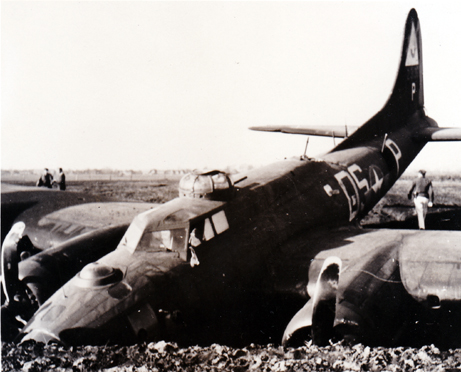
Close-up of the "No Balls"
(Courtesy of the CRASH Air War and Resistance Museum '40-'45
Aalsmeerderbrug, The Netherlands)
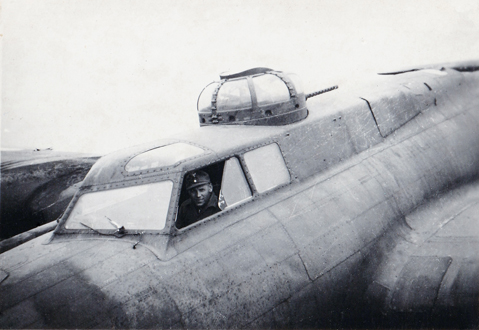
A German soldier sits in the pilot's seat as he smiles for the camera
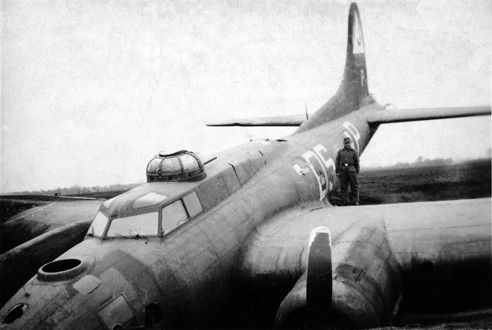
Soldiers stand guard until the "No Balls" is hauled off for scrap
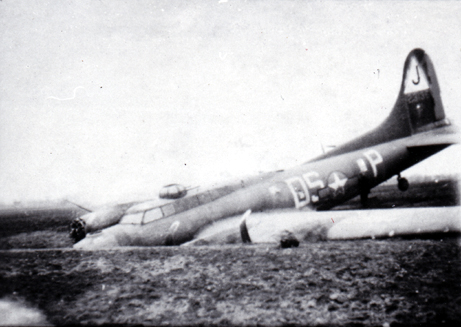
Above three photos acquired post-war by Mr. Jan van der Beek and
provided for this website courtesy of Mrs. Janny Herfst
Hoofddorp, The Netherlands
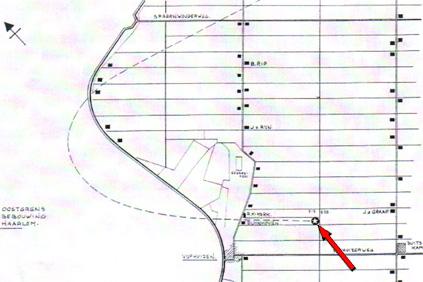
Diagram of the crash path of the "No Balls" over Vijfhuizen, Holland
(Courtesy of the CRASH Air War and Resistance Museum '40-'45
Aalsmeerderbrug, The Netherlands)
Art was thrown forward, and hit his head on the nose-mounted machine gun. He was knocked unconscious. The crew looked at him, and assumed he was dead. Some Germans were approaching, and were raking the plane with small arms fire. The remainder of the crew jumped out of the plane. As instructed under such conditions, the engineer placed an incendiary bomb on the wing. This device was supposed to burn its way through the wing into the gas tanks which would then explode.
It didn't work.
Art came to, and heard bullets strafing the plane. He climbed out of the co-pilot's window, and scooted along the ditch until he could join the rest of the crew who had already been captured. He noticed that they were startled to see him. They explained the part about the bomb on the wing later.
A German soldier searched him taking his watch, an engraved hunting knife his father had sent him, and anything else he wanted. He next pointed to Art's wedding ring. Art said, "No!" He pointed to the German's wedding ring which they wore on the right hand. The German got the message, and let Art keep his wedding ring. He then said to Art something he never forgot:
"For you, ze war ist ovah."
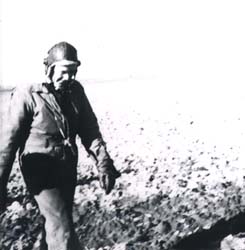
Art walking away from the plane
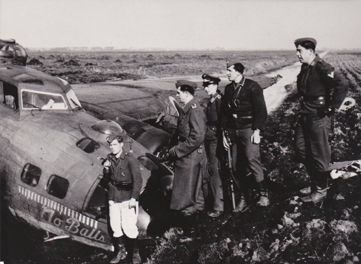
Germans who captured the crew
(Above two photos from the Starratt Family archives)
Additional information and photos regarding the crash site and disposition of the "No Balls".
Heinz Knoke is the German ace who was credited with the subsequent crash landing of Art's plane.